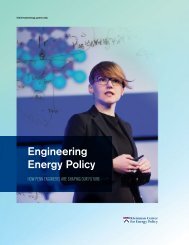2019-Annual-Report
You also want an ePaper? Increase the reach of your titles
YUMPU automatically turns print PDFs into web optimized ePapers that Google loves.
kleinmanenergy.upenn.edu 25
crucial for widespread renewable energy adoption. In their 2018
U.S. Renewable Portfolio Standards Status report, the Lawrence
Berkeley National Laboratory concluded that, “Roughly half of
all growth in U.S. renewable electricity (RE) generation and
capacity since 2000 is associated with state RPS requirements.”
DISADVANTAGED THROUGH POLICY
Tier 1 sources are given more renewable energy credit (REC)
rates than Tier 2 sources. Tier 1 renewable sources include solar,
wind, biomass, anaerobic digestion, geothermal, tidal power,
renewable fuel cells, small hydro, and poultry-litter incineration
facilities. Tier 2 sources include waste coal, distributed generation
systems, municipal solid waste (MSW), and large-scale hydro.
Under the RPS, municipal solid waste is not considered to be
a fully renewable resource, as the non-biogenic components
(e.g. glass, plastics, metals, etc.) are technically non-renewable.
However, the EPA defines renewable energy as, “fuel sources
that restore themselves over a short period of time and do
not diminish.”
Not only does MSW replenish periodically, but it also experiences
exponential growth: the World Energy Council projects that global
waste generation will double to over 6 million tons per day by 2025
and may reach over 11 million tons per day by 2100. Thus, by the
EPA’s own definition, MSW should be a fully renewable resource.
DESIGNING BETTER POLICY
A dangerous contradiction is thereby observed: the EPA’s strict
classification of “renewable” MSW (i.e. the biogenic components)
leads to greater landfill emissions. This should never occur in the
realm of energy policy, as the main goal of renewable technologies
is to foster a sustainable future for humanity.
The only way for the U.S. to become a global leader in waste
management, besides source reduction, is to pursue a complete
overhaul of our current model: we must enable WTE technologies
to replace landfills and increase recycling and composting efforts
throughout our nation.
To do so, the U.S. must enact favorable policies that designate
WTE as a Tier 1 renewable resource, define MSW as a completely
renewable feedstock, and provide favorable subsidies to new and
existing WTE facilities.
“It’s been an absolute
pleasure writing for the
Kleinman Center. I can’t
thank you all enough for
your support throughout
the process.”
—RICHARD LING
COMPONENTS OF MSW BY PRODUCT TYPE IN WEIGHT (U.S.)
300K
THOUSANDS OF TONS
200K
100K
0
1960 1970 1980 1990 2000 2010
◼ Durable Goods ◼ Nondurable Goods ◼ Containers & Packaging ◼ Food ◼ Yard Trimmings ◼ Other Wastes




